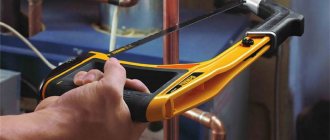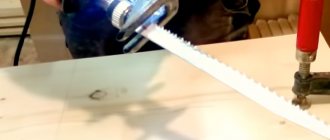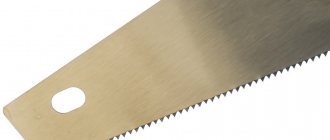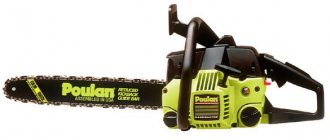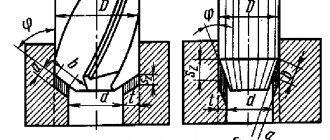Even in conditions of widespread Bulgarians and other types of metal-cutting hand tools traditional hacksaws for metal have not sunk into oblivion. Sometimes it is much easier, faster and safer to cut metal manually, using an ordinary saw blade.
The main difference between saws for metal and wood is the height of the teeth. In hacksaws for cutting metal, the teeth have a height of 1-1.5 (mm). For cutting wood, higher teeth are used, from 2 to 5-7 (mm) and even more.
A hacksaw is a saw designed for cutting metal workpieces. This tool consists of a frame and a saw blade. Unlike the vast majority of saws for wood, in saws for metal the blade is rigidly attached. The only exceptions are hand saws for metal with one-sided fastening.
Of course, today the position of hacksaws for metal has been greatly replaced by grinders and band saws . When performing voluminous work, that is, cutting a large number of workpieces, it makes sense to use the same grinder. When you need to make only 1-3 cuts, then very often craftsmen give preference to a hand hacksaw for metal .
Let's talk about the types of hacksaws for metal.
Characteristics and purpose
The main purpose of a hacksaw is to cut various materials. The main one is metal, but since there are many small teeth on the blade, it can be used to separate:
- plastic;
- ceramics;
- polyvinyl chloride;
- Styrofoam;
- particle boards;
- laminate;
- plexiglass;
- tree.
When choosing a hand tool, you need to pay attention to the blade. Blades are manufactured according to the requirements of GOST R 53411-2009. This document describes the standards by which hacksaw blades are divided into three groups, differing in size:
- Double. The distance between the holes for fastening into clamps is 300 mm (permissible error 2 mm). Blade length - 315 mm. The height of the teeth is 20 mm. Thickness - 0.8 mm.
- Single. The distance between the mounting holes is 300 mm. The permissible error is 2 mm. Total length - 315 mm.
- Single shortened. The distance between the mounting holes is 250 mm. Total length - 265 mm.
The height of single panels is 12.5 mm, thickness is 0.63 mm.
Plexiglas in packaging (Photo: Instagram / rezka_stekla_soln)
Design
The hacksaw consists of several parts:
- Blades for hacksaws for metal. This is a removable item. It is used to cut workpieces made of different materials. It is a metal strip on which wedge-shaped teeth are located.
- Machine or frame. It is an arc that is made of different metals and alloys. The frame is needed to secure the canvas. It can be standard cast or sliding.
- Handles. It can be located in different places.
Modern hand tools can be equipped with additional mechanisms to increase comfort during work and expand functionality.
Hacksaw blades (Photo: Instagram / enerteh.by)
Types of hacksaws
Varieties:
- Household. Standard hand tools for occasional household tasks. The handle is made of wood, and an adjustment screw is installed on the front of the frame.
- Hand saws. A compact tool designed for sawing metal in hard-to-reach places. Suitable for securing broken saw blades.
- Professional models. Their main difference is the high quality of materials from which the main parts of the structure are made.
You also need to pay attention to the division of hacksaws by drive type. They are electric and manual. Electric ones are divided into battery and network. The former allow you to work without connecting to the mains, which makes them more versatile, but the batteries gradually discharge and require charging, which reduces the time you use the power tool. Battery models are equipped with special systems to suppress vibrations.
Household hacksaw (Photo: Instagram / ploskogubtsy.ru)
What does it consist of?
The instrument in question has a very simple and understandable design. If we talk about manual models, they look like a bracket, between the ends of which a stretched canvas is fixed.
Typically, the tool also includes a frame and a hacksaw blade. Each of the components has its own subtleties and characteristics and each of them is irreplaceable.
For example, the frame secures the blade for cutting. It can be created from various materials depending on what you have to work with. For example, if we are talking about cutting some hard products, then it is better to use an option made from very durable composites. Also, the frame structure will be directly dependent on the conditions of use.
For example, if you regularly have to deal with cutting iron in hard-to-reach places, then it is better to buy a model that will have a tilt regulator for cutting blades or a not very large frame.
The hacksaw device will be incomplete without a blade. We are talking about a thin strip made of steel. Despite this, it is the most fragile part of this device. For this reason, you should be very careful and attentive while working. Otherwise, the canvas will simply break. This part has special wedge-shaped teeth.
When selecting a saw, you should pay attention to whether the teeth of the blade have been hardened. The fact is that this procedure allows you to significantly increase the time you use the tool and its performance characteristics.
If you need to cut hard metal products, then blades with not too large teeth are used, and soft versions are processed with large cutters. It is better to purchase bimetallic or hardened solutions. They should be placed in a canvas frame so that the teeth are in the opposite direction from the handle.
Types of hacksaw blades
The hacksaw blade is considered the main part of the hand tool. The performance of the tool and the cutting accuracy depend on its type.
Metal cloth
It has a large number of small teeth. Large teeth will not cut metal.
Blade length - 150–300 mm. The canvas can be made from different materials:
- carbon steel;
- cobalt steel;
- carbon and high-speed steel.
Tungsten filament
Strings are made from tungsten carbide. Their length is 30 cm. They are suitable for fastening within standard hacksaws. String diameter - 2.7 mm. With its help you can make precise cuts. The string is suitable for straight and curved cuts, cutting out circles.
Diamond string
The basis of such a string is alloy steel, onto which diamond coating is applied. Coating thickness - 2 mm. The string is secured in the clamps using rings.
A high-quality diamond wire should quickly cut through various materials. When working, its surfaces and working area must be moistened with water to avoid overheating.
It is better to choose an arc with a handle and attach a diamond string to it. Such a hacksaw is cheaper than a professional hand tool, but it can be used to cut metal, concrete, stone, ceramics, etc.
Diamond string (Photo: Instagram / abraziv_ykt)
The best electric hacksaws for metal
Makita JR3070CT
Saber type model. Designed for professional activities. Can cut thick metal products. Cutting depth – 255 mm.
Characteristics:
- The average cost is 18,000 rubles.
- Weight – 4.6 kg.
- Power – 1510 W.
Makita JR 3070 CT belongs to the network tool. The length of its cable is 2.5 m.
Advantages:
- reliability;
- adaptation to prolonged loads;
- double insulation;
- 5 stages of speed adjustment;
- reinforced body.
Replacing the working blade does not require special tools. The gearbox has a splitting clutch, which reduces the degree of kickback of the tool when the blade jams during operation.
The disadvantage is the lack of illumination of the work area.
Owner reviews:
| Vasily Ch. | Alexey I. |
| Decent tool. Completely justifies its price. Never let me down. | The tool is easy to use. Withstands long-term loads. |
Bosh GSA 10.8 V-LI
Saber type model with stepless speed control. The speed is increased using the “start” button. The electric hacksaw runs on batteries.
Characteristics:
- The average cost is 14,000 rubles.
- Weight – 1.2 kg.
- Battery capacity – 2 Ah.
The tool is equipped with an indicator that gives a signal during operation about possible overload. The penetration depth depends on the density of the metal. For metal pipes – 50 mm.
Advantages:
- light weight;
- battery protection from overheating;
- presence of illumination of the working area;
- ease of maintenance;
- reliability.
The disadvantage is the limited operating time of the battery.
Owner reviews:
| Vladimir T. | Sergey I. |
| Easy to use, lightweight tool. Even a woman can cope with it. | I like that the electric hacksaw has a spare battery. Powerful despite its small size. |
Stomer SSS-1000
Inexpensive saber type model. Has smooth speed control and a quick-release chuck. It is a professional tool, but can be used at home for cutting metal and wood.
Characteristics:
- Average cost – 6500 rubles.
- Weight – 3.85 kg.
- Power – 1100 W.
Thanks to its good insulation, the electric hacksaw can be used to work in explosive areas.
Advantages:
- increased safety at work;
- good power;
- ease of maintenance.
Owner reviews:
| Dmitry P. | Gennady F. |
| The electric hacksaw is reliable, works for 3 years without breakdowns. | The electric hacksaw is a little heavy, but it cuts perfectly. |
Selection principles
When purchasing a hacksaw for metal, you need to consider a number of criteria. It is important to study the strengths and weaknesses of the instrument and understand the manufacturers.
Criteria
Criterias of choice:
- The material from which the handle is made. Comfort when working with a hacksaw will depend on this. It is better to choose handles with rubber pads.
- The shape of the teeth, their size. They should not be large in order to cut metal without problems.
- Canvas size. Depends on the length of the workpieces being cut.
It is better to put aside a tool with a hollow handle, since it will break if pressed hard.
Mini hacksaw for metal (Photo: Instagram / wedotools)
Advantages
Positive sides:
- simplicity of design and maintenance;
- light weight;
- performing work in any conditions;
- reliability, durability;
- possibility of sharpening;
- application for sawing various materials;
- ease of use.
Manufacturers and prices
Manufacturers:
- "Enkor"
- Stanley;
- STAYER;
- GROSS;
- Top Tools.
The average price is 500 rubles.
Assortment of hacksaws (Photo: Instagram / stroi_it)
Preparatory stage
First, the material to be processed is firmly secured in a vice. And it must be secured in such a way that it is convenient for the worker to work. Next, in accordance with the hardness, shape and size of the workpiece to be cut, a hacksaw blade is selected. If the rafters are long, it should be with a large tooth pitch, if short - with a fine one.
The hacksaw is installed in the slots of the head so that the teeth are not directed towards the handle. The end of the blade is inserted into the stationary head and secured using a pin , then the second end of the blade is placed in the slot of the pin, which is secured with a pin. The blade is tensioned manually (you cannot use a vice or pliers) by rotating the wing nut. The hacksaw should be kept away from your face.
With a slight distortion, the canvas, stretched tightly, and with significant pressure, weakly stretched, lead to bending, which is why a break is possible. The degree of tension is checked by pressing the finger on the side: if there is no deflection, the tension is sufficient.
Operating principles
To make cutting metal with a hacksaw more effective, when working with hand tools you must adhere to some rules:
- You need to hold the tool with both hands so that the blade does not bend. It is better to secure the workpieces in a vice.
- The ease of use of the tool can be increased by changing the cutting angle.
- The pressure must be increased when moving forward, and decreased when moving backward.
- It is important to practice in advance in securing the canvas in the clamps. It is important that it does not move when sawing.
Before you start working with a hacksaw, you need to check the sharpness and integrity of the teeth, their location relative to each other. If there are irregularities, the teeth move in different directions, the blade needs to be replaced.
Cutting a metal pipe (Photo: Instagram / ekb_tools)
Tooth shape and how it affects performance
There are different types of woodworking materials, so it is entirely appropriate to produce blades with different tooth shapes. Let us find out in detail what types of teeth these are.
- Universal oblique teeth - designed for longitudinal sawing of wood. The teeth have the shape of an oblique triangle or hook. Such teeth are sharpened on both sides and at an angle of 60 degrees. A tool with oblique teeth is distinguished by its productivity, as well as its efficiency in sawing wood not only across, but also along
- Chisel-shaped - such teeth are also called chisel-shaped, and they look like right triangles. You can find such a tuyere of teeth in tools such as axing saws or rewards. Sharpening of teeth is carried out only on one side, and sawing is carried out only in one direction when moving away from you
- Dagger-shaped teeth - look like an isosceles triangle. Used for cutting in two directions. The teeth on such blades are set apart at equal distances. The tool can be used for both longitudinal and cross cuts
- Wolf teeth are special teeth that are designed exclusively for sawing raw wood. The special design of the cutting links made it possible to achieve maximum efficiency when cutting raw wood. The secret of high productivity is that the sizes of the depressions between the teeth alternate, so when moving the blade along the wood, sawdust is effectively removed from the cut site
- Ground teeth - grinding the top of the links reduces productivity, but at the same time improves the quality of the cut. Such blades are not suitable for cutting trees, but no work with laminate is complete without them.
- Japanese tooth is a special form of links that looks like wedges directed in the opposite direction. Such tools do not require additional setting, since the teeth are quite thick and durable. When sawing wood, such teeth show high efficiency, and the cut is performed primarily towards itself. This tooth shape is called Japanese not because its design was invented in Japan, but because it is in that country that it is customary to saw in the direction not from oneself, but towards oneself. This is a great option for those looking for a good mid-priced hacksaw
This is interesting!
Do you know what effects sawing with a hacksaw on wood away from you or toward you?
When sawing away from you, shavings or sawdust from the cut site are released in the opposite direction from the master. The higher the efficiency of the tool, the correspondingly more expensive it is. The most expensive are hacksaws with wolf teeth and Japanese teeth. For the home, a tool with a classic shape of cutting links is quite enough.
https://youtube.com/watch?v=WLQVEi9KOP4%3F
Manufacturing
Any person without practical skills can make a homemade metal hacksaw. It is important to study in advance the structure of hand tools and how to connect the main parts.
A handle with an arc can be made from large-diameter wire, fittings, metal strips, profiled or plastic pipes. All that remains is to think about fastening the canvas.
A hacksaw is a hand-held tool for sawing workpieces made of different materials. To create high-quality cuts, you need to learn how to choose blades. We must not forget about the rules for choosing a frame with a handle. It is important that the tool is comfortable to work with and that the blades are securely held in the clamps.




